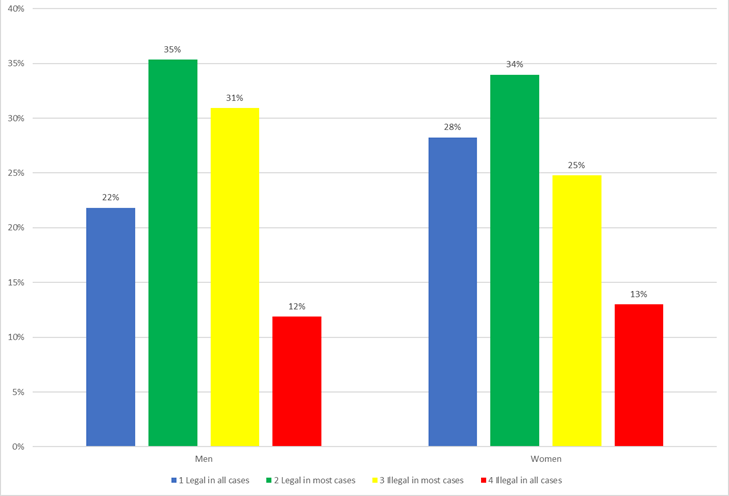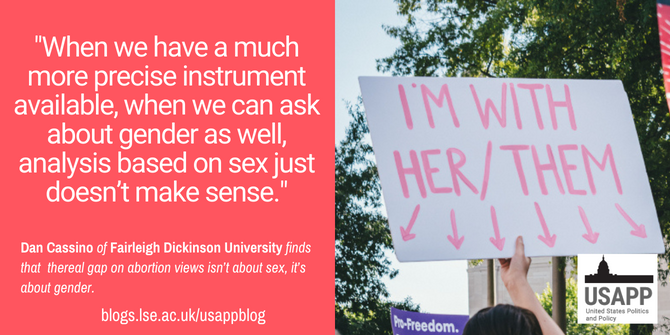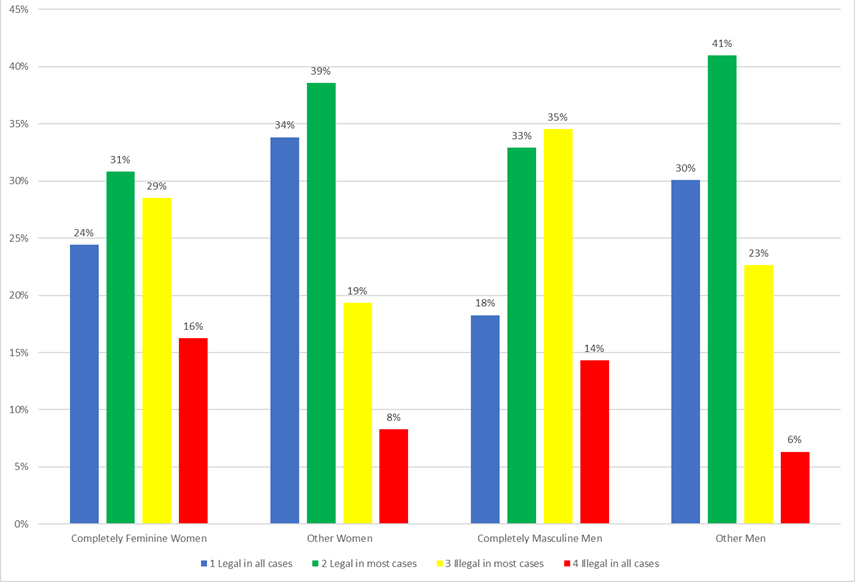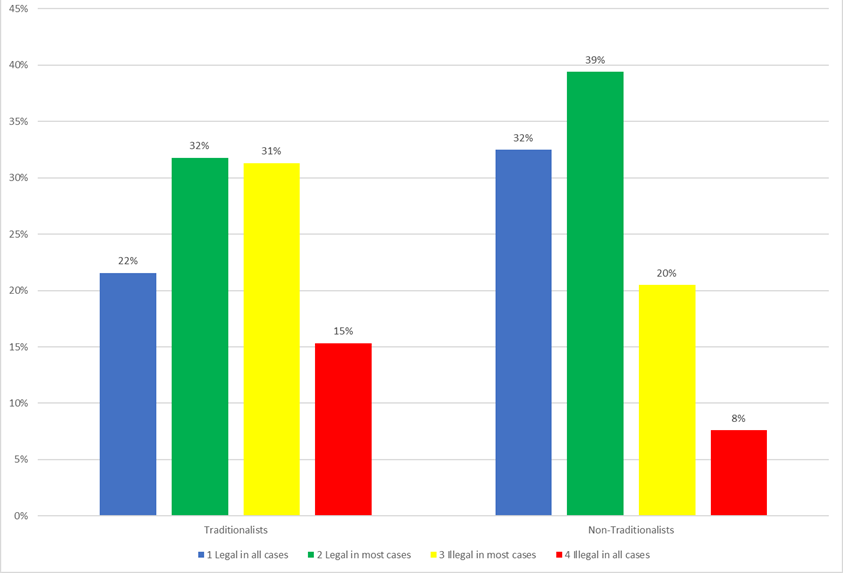 With the 2022 midterm elections only a month away, there are indications that the Supreme Court’s decision to overturn Roe v Wade may have motivated women to support Democratic candidates. In new research, Dan Cassino examines Americans’ views on abortion. He finds that people’s gender identity and their attitudes towards gender are far better predictors of their views on abortion than their sex.
With the 2022 midterm elections only a month away, there are indications that the Supreme Court’s decision to overturn Roe v Wade may have motivated women to support Democratic candidates. In new research, Dan Cassino examines Americans’ views on abortion. He finds that people’s gender identity and their attitudes towards gender are far better predictors of their views on abortion than their sex.
Not long ago, Democrats were bracing for a crushing defeat in the upcoming US midterm elections; but the Supreme Court’s Dobbs decision, overturning Roe v Wade and allowing states to impose greater restrictions and even bans on abortion seems to have motivated Democratic voters. Reports indicate a surge of younger women registering to vote and casting ballots, combined with missteps among Republican candidates and declining gas prices have left Democrats cautiously optimistic about retaining control of the Senate, and maybe even the House of Representatives. Pundits and pollsters are now asking if abortion will drive enough women voters to help Democrats buck the general trend of losing seats in the midterm; but any analysis of abortion views that looks at women versus men is missing the point. The real gap on abortion isn’t about sex; it’s about gender.
Understanding views on abortion
Using 2020 data from USC’s Understanding America survey (a nationally representative sample with about 5000 cases), we can see the importance of this distinction. When we look at the breakdown in abortion views by sex (Figure 1), there are modest differences between men and women: women are a little more likely to say that abortion should always be legal (28 percent versus 22 percent), and men are a little more likely to say that it should be illegal in most or all cases (43 percent versus 38 percent). There’s a gap, but it isn’t huge, with most men and women in the middle categories, saying that it should be legal in some cases, but not others (66 percent of men and 59 percent of women).
Figure 1 – Abortion views by sex

The problem with an analysis of abortion views based on sex is that it’s conflating two concepts: sex and gender. There aren’t many social scientists who are going to argue that someone’s reproductive organs make them hold certain social or political views; rather, it’s the way that those organs shape the way that they’re raised, the roles they adopt in society, and the corresponding differences in the way that they’re treated and how they view their own role in society. Put another way, social and political views aren’t driven by sex so much as gender: a distinction that often gets overlooked because social scientists and pollsters generally don’t ask about gender (and are often squeamish about asking questions about sex, relying instead on telephone interviewers’ judgment about a respondent’s voice).

Photo by Gayatri Malhotra on Unsplash
When we break down abortion views by the gender identities that people express, we get a very different story. While there are several ways to measure gender identity, a simple question asking people to place themselves on a scale running between “completely masculine” and “completely feminine” works well for most populations (more complex scales can be used when dealing with populations who are expected to have more diversity in their gender identities). When asked this question, about half of Americans express a gender identity that’s “completely” corresponds to societal expectations about their sex: “completely feminine” women and “completely masculine” men. Most of the remainder express a gender identity that’s mostly in line with it, and less than 10 percent express a gender identity that’s seen as corresponding to the opposite sex (with women being more likely to say that they’re masculine than men saying that they’re feminine).
Forty-five percent of “completely feminine” women say that abortion should be illegal in most or all cases, compared with just 26 percent of other women. Similarly, 49 percent of “completely masculine” men say that abortion should be mostly or always illegal, compared with 31 percent of other men. Put another way, “completely feminine” women have much more in common with “completely masculine” than they do with other women. Just so, men who don’t assert a “completely masculine” gender identity have abortion attitudes much closer to women who don’t say that they’re “completely feminine” than they do with other men.
Figure 2 – Abortion views by sex and gender identity

How attitudes towards gender shape views on abortion
The importance of gender – rather than sex – in shaping attitudes on abortion is even clearer when we ignore sex entirely and look just at gender traditionalists (completely masculine men and completely feminine women) versus everyone else. Forty-six percent of gender traditionalists think that abortion should generally be illegal, compared to just 28 percent of non-traditionalists. Contrast that 18-point gap with the five-point gap (43 percent for men, 38 percent for women) in the division based on sex. If your analysis of abortion views divides up the public based on sex, you’re missing the real difference.
Figure 3 – Abortion views by gender traditionalism

Of course, gender traditionalism corresponds with other characteristics as well. Traditionalists tend to be older, more Republican, and less educated than gender non-traditionalists, and these factors also play an important role in shaping socio-political views, especially with regard to gendered issues like abortion rights. But even within those categories, gender matters: traditionalist Republicans and Democrats hold different views than their counterparts with less traditional gender identities. The role of gender in shaping political views also varies by the issue: on something like gun control, for instance, traditionalism doesn’t seem to matter very much, with the real gap coming between masculine men and everyone else.
The Dobbs decision, and the subsequent laws limiting or removing abortion rights in many states are likely to be a driving force in the upcoming midterm elections in the United States, but any analysis that looks at it as an issue for women, but not men, is missing the real distinction. Women with traditional gender identities are more likely to support total abortion bans than men are (16 percent versus 12 percent). When it comes to social and political views, sex is a blunt instrument: it works as a predictor because it corresponds with gender identity for most people, most of the time. But when we have a much more precise instrument available, when we can ask about gender as well, analysis based on sex just doesn’t make sense.
- Please read our comments policy before commenting.
- Note: This article gives the views of the author, and not the position of USAPP – American Politics and Policy, nor the London School of Economics.
- Shortened URL for this post: https://bit.ly/3ycx3Ib







thanks, this is a really interesting take on this issue. it gels with the strong pro-life support I’ve seen in surveys from women in the most conservative states (and fits in quite intuitively)
oh.. can you also direct us to where to actually find the survey/survey questions/data on the site you linked?